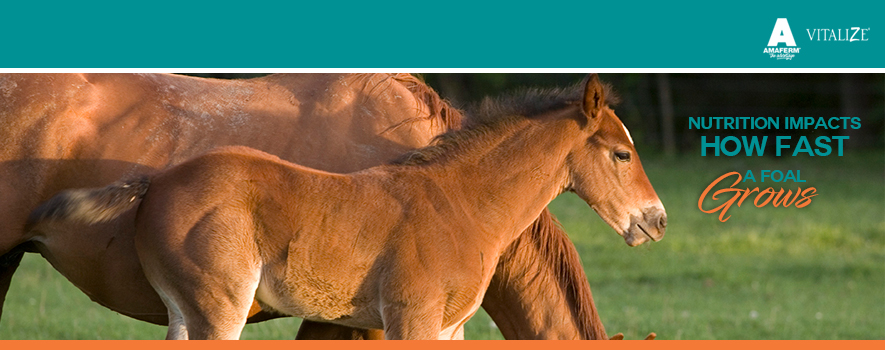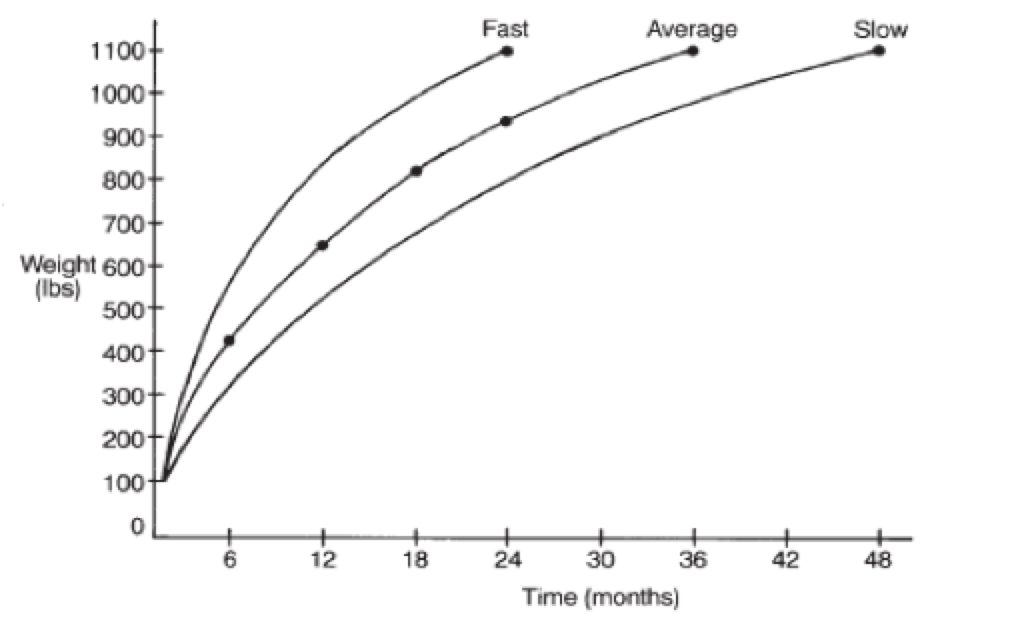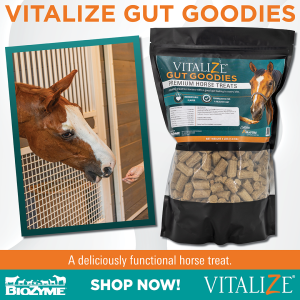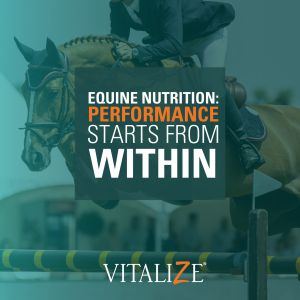
The nutritional start a foal gets can have a profound effect on its health and soundness for the rest of its life. As the foal’s dietary requirements shift from milk to feed and forage, your role in providing adequate nutrition is vital.
 According to the National Research Council (NRC), at three months of age a foal should be gaining about two pounds per head, per day. This is a critical stage regarding nutrition, since growth and development occur rapidly. If the mare is milking normally, the foal won’t start nibbling on feed until one month of age. The nutritional content of the mare’s milk declines significantly about two weeks post foaling. The foal’s nutritional requirements continue to increase beyond the first two months up to almost one year of age.
According to the National Research Council (NRC), at three months of age a foal should be gaining about two pounds per head, per day. This is a critical stage regarding nutrition, since growth and development occur rapidly. If the mare is milking normally, the foal won’t start nibbling on feed until one month of age. The nutritional content of the mare’s milk declines significantly about two weeks post foaling. The foal’s nutritional requirements continue to increase beyond the first two months up to almost one year of age.
The above figure shows the typical growth patterns, measured by body weight gains, of horses with an expected mature weight of 1,100 lbs. It also points out several important concepts about the growing horse.
First, the horse has a genetic maximum and this expected mature size is determined by ancestry. Second, horses have the potential to grow rapidly in early life. The rate of growth is influenced significantly by nutrition. On average, horses reach their mature height and weight at approximately 36 months of age. The age at which a horse reaches its mature height and weight can be shortened to approximately 24 months or lengthened to longer than 48 months depending upon management and genetics. Spinal process (wither) growth is generally not complete until five years of age.
So what exactly is the “right thing” to do when it comes to evaluating the nutrition of young horses? Remember everything is based on energy. The more energy they take in the more nutrients they have to digest, absorb and grow. However, too much energy and they will grow too fast for their internal organs and bones to keep up, which can also lead to DOD’s. It is important to remember that the nutritional needs of the foal are completely separate from the mare.
When balancing the foal ration it becomes imperative to ensure that it has all of the necessary nutrients needed. They need protein to build muscle mass, they need it to build a strong immune system and they need it as fuel for their muscles. If there are not enough carbohydrates or fat in the diet then they will use protein for energy. The building blocks for protein are amino acids. If there is a limiting amino acid then all of the protein requirements cannot be met and growth will be inhibited. For foals, the limiting amino acid is lysine. The general rule of thumb is that if lysine requirements are met, protein requirements are met.
Foals need fat. It is an important energy source that can be stored and allow them to gain weight, and it also helps with the absorption of some vitamins and minerals. As the foal’s gut develops, their hindgut will produce volatile fatty acids from eating hay. In the hindgut, hay is broken down and fermented by healthy bugs, which produces volatile fatty acids. Volatile fatty acids are an excellent energy source for the horse.
The daily energy requirements of the foal can be satisfied by providing it with a diet of enough energy to meet its needs taking all of the above into consideration. Yearlings restricted to forage will usually be able to consume enough energy to provide for its maintenance needs and support some growth. However, seldom will the animal be able to consume enough energy from the forage to support a growth rate compatible with the animal’s genetic potential. The concentrate (grain ration) therefore becomes a key component in providing adequate energy. The NRC recommended energy intake of growing foals can usually be met with a concentrate to forage ratio of about 70:30 for weanlings and 60:40 for yearlings. Since horses of this age will consume about 2.4 to 2.6 lb/100 lb BW of as fed feed daily, this would mean that a 600 lb weanling would consume 9.0 to 9.6 lb of concentrate (60 – 64%) and 5.4 to 6.0 lb of hay (36 – 40%) daily. This is compatible with the generally accepted principle that horses should consume at least 1.0% of their BW in forage daily to maintain good digestive function. Some variation around this ideal ratio is acceptable and may even be expected but care should be exercised not to let it vary too heavily toward the concentrate.
Feeding young horses is a balancing act that needs to be considered through out the first three years of its life. Making sure the feeding regimen is providing enough, but not too much, energy is key to the horse it will become.
Amaferm helps in three key ways:
- Amaferm has been research proven to increase volatile fatty acids in the horse. Remember In the hindgut, hay is broken down and fermented by healthy bugs, which produces volatile fatty acids. Volatile fatty acids are an excellent energy source for the horse.
- Amaferm has been research proven to increase the utilization of nutrients so the animal gets the most out of the diet offered to the animal.
- Amaferm has been research proven to increase the digestibility across numerous types and qualities of hay, allowing the horse to get more energy from the hay. This translates into being able to feed a higher percent forage diet which translates into good digestive function.
You can find Amaferm in all our of our Vitalize products.
Click here to read our previous post about Feeding the Soon To Be New Mom.

